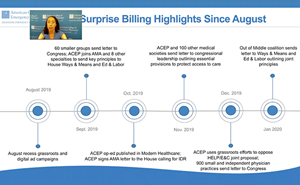Thousands of organizations and individuals flooded the Regulations.gov webpage with comments at the end of last week responding to two regulations on telemedicine prescriptions: one related to buprenorphine, and the other focusing more generally on controlled substances. As I mentioned in a previous Regs and Eggs blog post, many telemedicine advocates expressed dismay that the Drug Enforcement Administration (DEA) decided to propose permanent telemedicine policies that were more restrictive than those the agency allowed temporarily during the COVID-19 public health emergency (PHE)—and that dismay was clearly reflected in many of the comments that the DEA wound up receiving on its regs.
ACEP chose to focus our comments on one of the two regs—the one related to prescribing buprenorphine. We have strongly advocated for reducing barriers related to the treatment of opioid use disorder (OUD), so we do see an expansion of the use of telemedicine as a step in the right direction. We also believe that you as emergency physicians can effectively manage patients and prescribe buprenorphine safely via telemedicine without an in-person encounter. Therefore, as reflected in our comments (described below), we push back on several of the most restrictive policies in the reg—as we believe that they could hinder patients’ access to this life-saving medication.
As a reminder, in the buprenorphine reg, the DEA proposed to continue to allow the use of telemedicine to initially prescribe buprenorphine (but not methadone) for the treatment of OUD in cases where patients have never been treated in-person by the prescriber before. However, in these circumstances, the DEA proposed a prescription limit of 30 days (it can be multiple prescriptions as long as the total number of days does not exceed 30), after which an in-person examination would be required in order to receive refills. In addition, before prescribing buprenorphine via telehealth, physicians and other practitioners licensed to prescribe controlled substances must consult a prescription drug monitoring program (PDMP). If the practitioner is unable to consult a PDMP for some reason (if the PDMP is down or if the practitioner is unable to access it), the practitioner can only prescribe up to 7-days’ worth of medication until the practitioner is able to consult the PDMP. The DEA chooses to be restrictive about initial telehealth prescriptions because of its overall concerns about diversion and improper use of medications. In the reg, the DEA points out that diversion of buprenorphine is dangerous and may lead to misuse and sometimes fatal drug poisonings.
In our response, we make three major recommendations on how the DEA should modify its proposed buprenorphine telemedicine policies:
- Advocate for a 90-day instead of a 30-Day Prescription Limit: ACEP expresses concerns about the 30-day limitation for buprenorphine prescriptions. We acknowledge the DEA’s reasoning that obtaining an in-person medical appointment with a practitioner is often difficult due to the shortage of health care workers and various economic, geographical, sociological, and logistical limitations. However, these limitations are not entirely dissolved after 30 days. Many patients have transportation challenges and inflexible work schedules and must navigate finding an in-network provider that is accepting patients. It also takes significantly longer than 30 days to find an appointment in some areas. We therefore request that DEA extend the limit to 90 days so patients can more easily maneuver these logistical barriers.
- Eliminate the PDMP restrictions: ACEP believes that PDMPs play an important role in addressing the opioid crisis as well as deaths related to other prescriptions drugs. Physicians should make good faith efforts to consult PDMPs before prescribing controlled substances. However, although instances in which a PDMP is inaccessible, such as a server outage, disconnect with the electronic medical record, or a ransomware attack, are rare, they are not impossible occurrences. Infrequent instances in which the PDMP is inaccessible should be documented but should not impede the ability to prescribe a greater supply of buprenorphine, which may cause a disruption in care. Practitioners and patients should not be punished for something out of their control, including non-operational PDMPs. Therefore, the DEA should omit the stipulation that a practitioner can only prescribe up to 7-days’ worth of medication until the practitioner is able to consult the PDMP from the final rule.
- Tone down the diversion rhetoric: ACEP pushes back against the DEA’s assertion that “diversion of buprenorphine and other prescription opioids remains an issue across the country.” The DEA’s evidence to make its assertions around diversion are based on findings prior to the COVID-19 PHE in which the flexibilities in prescriptions via telemedicine were granted. Therefore, we believe more investigation is necessary to analyze the effects of telemedicine prescribing of buprenorphine on diversion and health outcomes. We also ask that the DEA consider numerous other studies that demonstrate that diversion is decreasing. Further, when diversion does occur, it appears from studies that individuals actually wind up using it for its intended purpose, and the only reason why it was diverted initially was because it was difficult to access through the proper channels.
Another area of confusion about the buprenorphine reg was that it is difficult to know for sure how it fits in with the more general reg on prescribing other controlled substances via telemedicine and whether some of the policies in the other reg are transferrable to the buprenorphine reg. For example, the Controlled Substances Telemedicine proposed reg allows a 180 day grace period for receiving an in-person visit for those patients who developed a telemedicine relationships with a practitioner during the COVID-19 PHE. Further, the Controlled Substances Telemedicine proposed reg permits a prescribing practitioner who receives a qualifying telemedicine referral for the patient to rely on the referring practitioner’s in-person medical evaluation in order to prescribe the controlled substance via telemedicine. However, this referral policy is not referenced in the buprenorphine proposed reg. Since there are inconsistent policies in each reg, we recommend combining the regs when they are finalized. Doing so would bolster consistency across the regulations and eliminate confusion regarding which policies apply to buprenorphine and which to other controlled substances.
We hope that the DEA takes these comments into consideration when the agency issues its final reg. Based on the nearly 3,000 comments that the DEA received on the buprenorphine reg alone (not to mention the 32,000 comments that the agency received on the Controlled Substances Telemedicine proposed reg), we may well see some policy changes—including those related specifically to the areas on which ACEP commented. Given the vast amount of interest in these proposed regs, the final regs will definitely be some of the most highly anticipated regs of the year!
Until next week, this is Jeffrey saying, enjoy reading your regs with your eggs!






